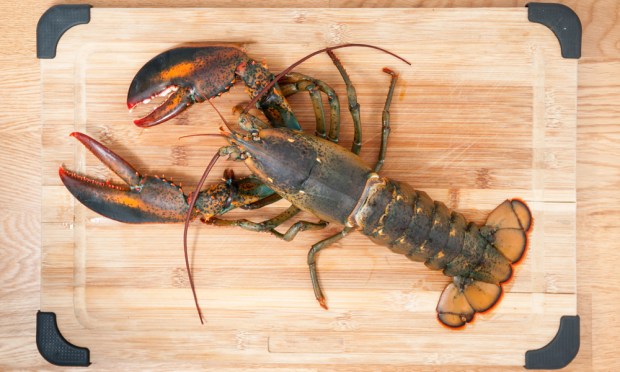How Lobster Wholesalers Keep Cross-Border Cash Flowing

China is crazy for crustaceans: The country imports more than $100M worth of them from the U.S. each year. But with the growing appetite and booming business has come cross-border receivables pain. In the latest X-Border Receivables Report, Stephanie Nadeau, owner of The Lobster Company, discusses the receivables risk U.S. wholesalers run — and why lagging cashflows are leading many to tighten their claws around the payments supply chain.
When it all boils down, the humble lobster has undergone a fairly complicated evolution in the food chain.
Once known as “the cockroach of the sea,” the lobster was commonly used by Native Americans as a source of bait and prison food. Fast forward to the mid-20th century, and the lobster began facing high demand in restaurants across the region.
In recent years, consumers in China have caught the same bug. In 2016, Chinese importers spent $108 million shipping lobster from the U.S., a rate 14 percent higher than what was reported as recently as 2010. What’s more, early data on last year’s import activity indicate Chinese appetite for lobster is growing further. In the first month of 2017, U.S. lobster exporters had already shipped $14 million worth of lobster to China.
One U.S. wholesaler helping to feed China’s recently acquired appetite for the crustacean is The Lobster Company of Arundel, Maine. Owner Stephanie Nadeau, who has more than two decades of experience in the lobster shipping industry, noted that the majority of her business is with wholesale buyers based in China. Nadeau recently spoke with PYMNTS about the factors that are driving demand and how she manages to keep her payments receivables steady while handling payments from clients overseas.
Insuring International Receivables
According to Nadeau, the Lobster Company exports roughly 2.5 million pounds of lobster each year.
Selling live lobsters is a delicate operation, especially when buyers are based overseas. Dealing with new buyers in international markets takes acumen, but on top of that, sellers always run the inherent risk of not getting paid.
The Lobster Company’s longstanding relationship with clients has helped them avoid issues and has ensured payments are received quickly and reliably, but that’s not always the case with other suppliers.
“I get paid quickly by wire transfer,” Nadeau said, noting that customers usually make their payments within five days of receiving their lobster shipments from the company.
But these types of steady and stable business relationships are not built overnight; they take time and effort, which has led Nadeau to invest in having a safety net against potential losses.
“We tend to have our receivables insured,” she said. “So, you sell to customers that have a certain amount of credit insurance.”
Having credit insurance to protect a certain dollar amount with a specific overseas customer offers merchants a way to recoup funds if something goes wrong with the transaction, she said.
“There are plenty of people [in the industry] who have gotten burned and not gotten paid,” Nadeau said. “You have to make sure you get your money.”
Investing in credit insurance also works to ensure that lobster merchants in the U.S. like Nadeau are connecting with customers who can meet their payment obligations. They also tend to avoid players who are looking to make “easy money,” as Nadeau described it, through a quick stint in the seafood industry.
“[Receivable insurance] is for finding legitimate customers, not fly-by-night customers,” she said. “The seafood industry is rife with them.”
A Protective Industry
It’s not always easy to tell if a customer is legit, but Nadeau said a common red flag in the seafood industry is the length of payment terms. The longer sellers must wait to receive their payments, the more alarm bells should go off, she said.
“If you sell to a large Chinese wholesaler, and they’re not paying you in seven to 14 days, you probably shouldn’t be selling to them,” she said.
In the event a lobster merchant does get burned by a buyer, receivable insurance can help the merchant recover some of the lost money.
In addition, Nadeau noted, information about which buyers are trustworthy and which ones need to be avoided spreads rapidly in the seafood community. Many players in the industry use resources like Seafax, Inc. to report, and to get help collecting, outstanding debt.
“There’s an inbred knowledge of who to sell to,” Nadeau said. “If someone burns somebody, everyone tells everyone so you don’t get burned too.”
Feeding the Importers’ Appetite
Nadeau has been in the lobster wholesale business for more than a quarter of a century. She began to notice an uptick in demand from China about a decade ago.
“I remember I went to a seafood show in China in 1998 and never sold lobster,” she said. “Now, the majority of my business is selling to China.”
Although she primarily deals with only two wholesale clients in China, Nadeau said these relationships are responsible for as much as 90 percent of the company’s export business. One of her clients distributes lobsters to merchants in “wet markets” — public marketplaces where merchants sell fresh (and sometimes live) meats — while another distributes lobsters to restaurants and hotels in the region.
According to Nadeau, one of the reasons lobster is such a hot commodity in China is that it’s considerably cheaper than other seafood meals in the market.
“It’s quite affordable,” Nadeau said. “Most restaurants [in China] have live tanks with fish, eels and skates. Lobsters are one of the most inexpensive items in live tanks, so it’s readily available.”
Nadeau said she’s also expanded her operations to a few customers in the Southeast Asia region, including Bangkok, Indonesia, Malaysia and Singapore. Based on recent trends, consumers in the Asian market are increasingly interested in lobster and are keen to add it to their menus.
With lobster in high demand in Asian markets, the “cockroach of the sea” has clearly evolved from a source of bait to a culinary trophy. If the industry that was built on the back (or should we say, shell) of this sea creature wants to continue to evolve and expand internationally, participating merchants are going to need some cross-border payments precision. Otherwise, merchants will be forced to claw their money back.

